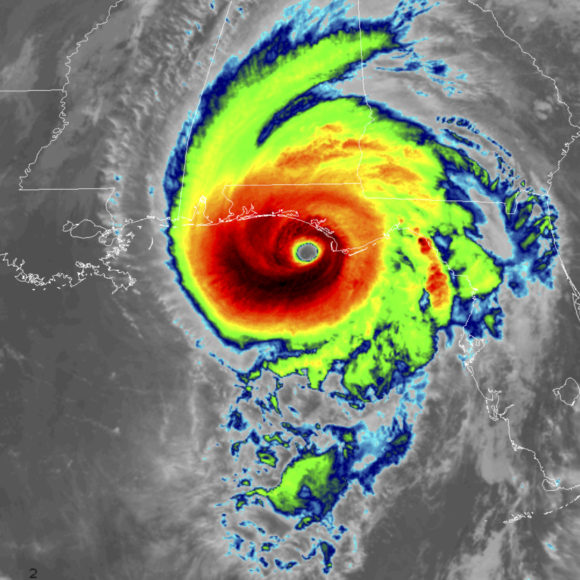The costliest natural catastrophes occurred in the United States in 2018 with one of California’s devastating wildfires and Hurricane Michael topping the list, according to Munich Re.
A report from Munich Re on last year’s natural disasters pointed to “clear indications” that man-made climate change is a factor in California’s wildfires.
Breaking down the losses, Munich Re said northern California’s November wildfire, known as “Camp Fire,” had overall losses of US$16.5 billion and insured losses of US$12.5 billion, while Hurricane Michael had overall losses of US$16 billion and insured losses of US$10 billion.
In total last year’s natural catastrophes racked up an overall global price tag of US$160 billion, said the reinsurer, noting that only half these economic losses were insured. The 2018 losses were below 2017’s significant loss total of US$350 billion, due mainly to record hurricane losses.
Last year’s insured losses of $80 billion were substantially above the inflation-adjusted average for the last 30 years (US$41 billion), but below 2017’s record figures of US$140 billion, said the reinsurer.
Munich Re said California saw its worst-ever wildfire season – for the second year running – with the state’s wildfires contributing US$24 billion to the overall 2018 natural catastrophe loss burden with US$18 billion of the total wildfire price tag covered by insurance.
Costliest Hurricane of 2018
From a global perspective, the 2018 cyclone season can be seen as statistically unusual, Munich Re said, explaining that tropical cyclone activity levels in the world’s different ocean basins usually vary from one place to another in intensity and frequency. In 2018, however, named tropical storms in all northern-hemisphere ocean basins outnumbered the long-term average. Indeed, the reinsurer said that cyclones worldwide caused above-average overall losses of US$56 billion, with approximately half of those losses covered by insurance.
Prominent among these was the high number of typhoons that hit Japan and the two direct hurricane strikes on the U.S. mainland: Hurricanes Michael and Florence.
The costliest hurricane of 2018 – and second costliest global natural disaster – was Hurricane Michael, which hit the U.S. mainland on Oct. 10 on the northwest coast of Florida. With wind speeds of 250 kilometers per hour (155 mph), it is the fourth-strongest storm ever to hit the U.S., with overall economic losses estimated at US$16 billion and insured losses of US$10 billion. Munich Re explained that insurance coverage was higher for this event because storm cover is widespread in the U.S., both in the private and commercial-industrial sectors.
Florence Flood Insurance Protection Gap
By contrast, the share of insured losses was much lower from Hurricane Florence, which hit the North Carolina coast just three weeks earlier in September. Munich Re said this is because most of the losses caused by Florence were due to flooding caused by Florence’s torrential rains, and insurance against flood damage is much less widespread in the U.S. than windstorm coverage. Florence had estimated insured losses of US$5 billion out of a total of US$14 billion in overall losses.
“It would certainly make sense to have higher insurance density against flood losses given that studies have shown the influence of climate change on torrential rainfall events on the Gulf of Mexico coast, such as Hurricane Harvey in 2017,” said Munich Re.
Climate Change Connection
“Our data shows that the losses from wildfires in California have risen dramatically in recent years. At the same time, we have experienced a significant increase in hot, dry summers, which has been a major factor in the formation of wildfires,” commented Ernst Rauch, head of Climate and Geosciences at Munich Re, in a statement.
“Many scientists see a link between these developments and advancing climate change. This is compounded by man-made factors such as burgeoning settlements in areas close to forests at risk from wildfire,” he added. “The casualties and losses are immense, and measures to prevent fires and damage are vital. Insurers also need to take account of the rising losses in their risk management and pricing.”
- Death Toll. Some 10,400 people lost their lives in 2018 as a result of natural catastrophes, compared with the average of 53,000 over the past 30 years. This long-term downward trend shows, from a global perspective, measures to protect human life are starting to take effect, said the reinsurer.
- California’s Woolsey Fire. The Woolsey Fire was raging at the same time as the Camp Fire, although in different parts of the state. The “Woolsey Fire” destroyed about 1,600 houses, mainly in the celebrity town of Malibu, which saw overall losses of US$5.2 billion, of which about US$4 billion was insured.
- Tsunamis. The deadliest disaster of 2018 was a seven-meter (23 foot) tsunami that devastated the Indonesian city of Palu on Sept. 28. Thousands of buildings were destroyed and some 2,100 people were killed. Another tsunami hit coastal regions of Sumatra and Java – islands of Indonesia – on the evening of Dec. 22, killing at least 400 people.
- European Costliest Disaster. Sustained drought, which caused substantial agricultural losses and many wildfires, was Europe’s costliest natural disaster of the year. Cereals and field crops ripened too early, livestock fodder became scarce, and partial or even complete crop losses were seen. Low water levels on many rivers lasted into the autumn, which reduced river traffic, affecting freight transport and the economy. Direct losses came to US$3.9 billion (€3.2 billion), with only a small proportion – US$280 million/€230 million – of these losses covered by insurance. The report explained that farmers in many countries only buy insurance against individual perils, usually hail.
- Japan’s Nat Cats. In 2018 seven storms hit or skirted the islands of Japan with five of those storms making landfall or coming very close to land at typhoon strength. The severest storm was Typhoon Jebi with overall losses of US$12.5 billion and insured losses of around US$9 billion, making it one of the costliest typhoons in Japan’s history. In addition, two earthquakes also caused losses of US$9 billion in total and insured losses of nearly US$2 billion. “Thanks to the strict building standards in Japan, damage was limited,” said Munich Re.
“Action is urgently needed on building codes and land use to help prevent losses. Given the greater frequency of unusual loss events and the possible links between them, insurers need to examine whether the events of 2018 were already on their models’ radar or whether they need to realign their risk management and underwriting strategies,” said Munich Re Board member Torsten Jeworrek in a statement.
Source: Munich Re
Topics Catastrophe Natural Disasters USA California Profit Loss Wildfire Flood Reinsurance Agribusiness Hurricane Climate Change
Was this article valuable?
Here are more articles you may enjoy.



 Adjusters Launch ‘CarFax for Insurance Claims’ to Vet Carriers’ Damage Estimates
Adjusters Launch ‘CarFax for Insurance Claims’ to Vet Carriers’ Damage Estimates  Zurich Makes £7.7 Billion Bid for Specialty Insurer Beazley
Zurich Makes £7.7 Billion Bid for Specialty Insurer Beazley  New York State Police Report 37-Vehicle Pileup on I-81 Near Syracuse
New York State Police Report 37-Vehicle Pileup on I-81 Near Syracuse  Update: Verizon Says Service Restored After Thousands Affected by Outage
Update: Verizon Says Service Restored After Thousands Affected by Outage 

